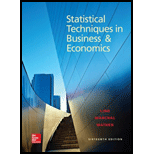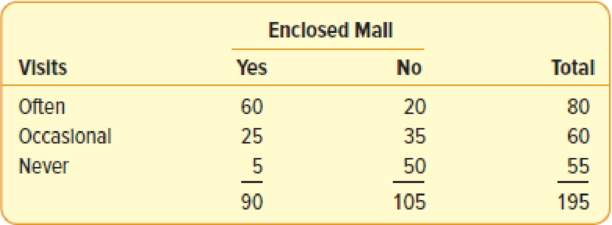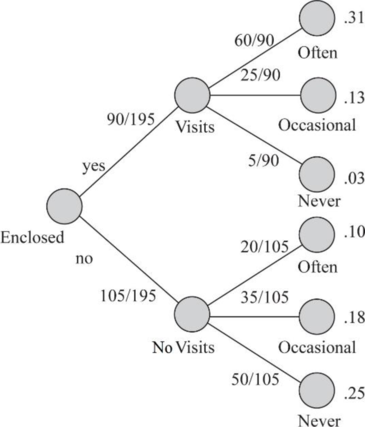
Concept explainers
Consumers were surveyed on the relative number of visits to a Sears store (often, occasional, and never) and if the store was located in an enclosed mall (yes and no). When variables are measured nominally, such as these data, the results are usually summarized in a

What is the
- (a) Visited a Sears store often?
- (b) Visited a Sears store in an enclosed mall?
- (c) Visited a Sears store in an enclosed mall or visited a Sears store often?
- (d) Visited a Sears store often, given that the shopper went to a Sears store in an enclosed mall?
In addition:
- (e) Are the number of visits and the enclosed mall variables independent?
- (f) What is the probability of selecting a shopper who visited a Sears store often and it was in an enclosed mall?
- (g) Draw a tree diagram and determine the various joint probabilities.
a.
Obtain the probability of selecting a shopper who visits a Sears store often.
Answer to Problem 8SR
The probability of selecting a shopper who visits a Sears store often is 0.4103.
Explanation of Solution
Here, number of shopper who visited Sears often is 80. Total number of shoppers is 195.
The required probability is obtained as given below:
Thus, the probability of selecting a shopper who visits a Sears store often is 0.4103.
b.
Obtain the probability of selecting a shopper in an enclosed mall.
Answer to Problem 8SR
The probability of selecting a shopper in an enclosed mall is 0.4615.
Explanation of Solution
Here, number of shopper who visited an enclosed mall is 90.
The required probability is obtained as given below:
Thus, the probability of selecting a shopper in an enclosed mall is 0.4615.
c.
Obtain the probability of selecting a shopper in an enclosed mall or visited Sears store often.
Answer to Problem 8SR
The probability of selecting a shopper in an enclosed mall or visited Sears store often is 0.5641.
Explanation of Solution
Here, number of shopper who visited an enclosed mall and often is 60.
Thus, the probability of selecting a shopper in an enclosed mall or visited Sears store often is 0.5641.
d.
Obtain the probability of selecting a shopper who visited Sears store often given that shopper went to a Sears store in an enclosed mall.
Answer to Problem 8SR
The probability of selecting a shopper who visited Sears store often given that shopper went to a Sears store in an enclosed mall is 0.6667.
Explanation of Solution
The required probability is obtained as given below:
Thus, the probability of selecting a shopper who visited Sears store often given that shopper went to a Sears store in an enclosed mall is 0.6667.
e.
Check whether number of visits and the enclosed mall variables independent.
Answer to Problem 8SR
Number of visits and the enclosed mall variables are not independent.
Explanation of Solution
Two events A and B are independent if
From part (d),
From part (a),
Thus,
f.
Obtain the probability of selecting a shopper in an enclosed mall and visited Sears store often.
Answer to Problem 8SR
The probability of selecting a shopper in an enclosed mall and visited Sears store often is 0.3077.
Explanation of Solution
Here, number of shopper who visited an enclosed mall and often is 60.
Thus, the probability of selecting a shopper in an enclosed mall and visited Sears store often is 0.3077.
g.
Construct a tree diagram that shows probabilities, conditional probabilities and joint probabilities.
Explanation of Solution
The first branch represents the shoppers visited enclosed mall which is divided into two categories. In the second branch, each category is subdivided into three different visits. The probabilities under the second branch represents conditional probabilities. The product of the probabilities in two branches represent joint probabilities.
The tree diagram is as given below:

Want to see more full solutions like this?
Chapter 5 Solutions
Statistical Techniques in Business and Economics, 16th Edition
- Question 5. We consider a put option with strike price K and expiration T. This option is priced using a 1-period CRR model. We consider r > 0, and σ > 0 very large. What is the approximate price of the option? In other words, what is the limit of the price of the option as σ∞. (Briefly justify your answer.)arrow_forwardQuestion 6. You collect daily data for the stock of a company Z over the past 4 months (i.e. 80 days) and calculate the log-returns (yk)/(-1. You want to build a CRR model for the evolution of the stock. The expected value and standard deviation of the log-returns are y = 0.06 and Sy 0.1. The money market interest rate is r = 0.04. Determine the risk-neutral probability of the model.arrow_forwardSeveral markets (Japan, Switzerland) introduced negative interest rates on their money market. In this problem, we will consider an annual interest rate r < 0. We consider a stock modeled by an N-period CRR model where each period is 1 year (At = 1) and the up and down factors are u and d. (a) We consider an American put option with strike price K and expiration T. Prove that if <0, the optimal strategy is to wait until expiration T to exercise.arrow_forward
- We consider an N-period CRR model where each period is 1 year (At = 1), the up factor is u = 0.1, the down factor is d = e−0.3 and r = 0. We remind you that in the CRR model, the stock price at time tn is modeled (under P) by Sta = So exp (μtn + σ√AtZn), where (Zn) is a simple symmetric random walk. (a) Find the parameters μ and σ for the CRR model described above. (b) Find P Ste So 55/50 € > 1). StN (c) Find lim P 804-N (d) Determine q. (You can use e- 1 x.) Ste (e) Find Q So (f) Find lim Q 004-N StN Soarrow_forwardIn this problem, we consider a 3-period stock market model with evolution given in Fig. 1 below. Each period corresponds to one year. The interest rate is r = 0%. 16 22 28 12 16 12 8 4 2 time Figure 1: Stock evolution for Problem 1. (a) A colleague notices that in the model above, a movement up-down leads to the same value as a movement down-up. He concludes that the model is a CRR model. Is your colleague correct? (Explain your answer.) (b) We consider a European put with strike price K = 10 and expiration T = 3 years. Find the price of this option at time 0. Provide the replicating portfolio for the first period. (c) In addition to the call above, we also consider a European call with strike price K = 10 and expiration T = 3 years. Which one has the highest price? (It is not necessary to provide the price of the call.) (d) We now assume a yearly interest rate r = 25%. We consider a Bermudan put option with strike price K = 10. It works like a standard put, but you can exercise it…arrow_forwardIn this problem, we consider a 2-period stock market model with evolution given in Fig. 1 below. Each period corresponds to one year (At = 1). The yearly interest rate is r = 1/3 = 33%. This model is a CRR model. 25 15 9 10 6 4 time Figure 1: Stock evolution for Problem 1. (a) Find the values of up and down factors u and d, and the risk-neutral probability q. (b) We consider a European put with strike price K the price of this option at time 0. == 16 and expiration T = 2 years. Find (c) Provide the number of shares of stock that the replicating portfolio contains at each pos- sible position. (d) You find this option available on the market for $2. What do you do? (Short answer.) (e) We consider an American put with strike price K = 16 and expiration T = 2 years. Find the price of this option at time 0 and describe the optimal exercising strategy. (f) We consider an American call with strike price K ○ = 16 and expiration T = 2 years. Find the price of this option at time 0 and describe…arrow_forward
- 2.2, 13.2-13.3) question: 5 point(s) possible ubmit test The accompanying table contains the data for the amounts (in oz) in cans of a certain soda. The cans are labeled to indicate that the contents are 20 oz of soda. Use the sign test and 0.05 significance level to test the claim that cans of this soda are filled so that the median amount is 20 oz. If the median is not 20 oz, are consumers being cheated? Click the icon to view the data. What are the null and alternative hypotheses? OA. Ho: Medi More Info H₁: Medi OC. Ho: Medi H₁: Medi Volume (in ounces) 20.3 20.1 20.4 Find the test stat 20.1 20.5 20.1 20.1 19.9 20.1 Test statistic = 20.2 20.3 20.3 20.1 20.4 20.5 Find the P-value 19.7 20.2 20.4 20.1 20.2 20.2 P-value= (R 19.9 20.1 20.5 20.4 20.1 20.4 Determine the p 20.1 20.3 20.4 20.2 20.3 20.4 Since the P-valu 19.9 20.2 19.9 Print Done 20 oz 20 oz 20 oz 20 oz ce that the consumers are being cheated.arrow_forwardT Teenage obesity (O), and weekly fast-food meals (F), among some selected Mississippi teenagers are: Name Obesity (lbs) # of Fast-foods per week Josh 185 10 Karl 172 8 Terry 168 9 Kamie Andy 204 154 12 6 (a) Compute the variance of Obesity, s²o, and the variance of fast-food meals, s², of this data. [Must show full work]. (b) Compute the Correlation Coefficient between O and F. [Must show full work]. (c) Find the Coefficient of Determination between O and F. [Must show full work]. (d) Obtain the Regression equation of this data. [Must show full work]. (e) Interpret your answers in (b), (c), and (d). (Full explanations required). Edit View Insert Format Tools Tablearrow_forwardThe average miles per gallon for a sample of 40 cars of model SX last year was 32.1, with a population standard deviation of 3.8. A sample of 40 cars from this year’s model SX has an average of 35.2 mpg, with a population standard deviation of 5.4. Find a 99 percent confidence interval for the difference in average mpg for this car brand (this year’s model minus last year’s).Find a 99 percent confidence interval for the difference in average mpg for last year’s model minus this year’s. What does the negative difference mean?arrow_forward
- A special interest group reports a tiny margin of error (plus or minus 0.04 percent) for its online survey based on 50,000 responses. Is the margin of error legitimate? (Assume that the group’s math is correct.)arrow_forwardSuppose that 73 percent of a sample of 1,000 U.S. college students drive a used car as opposed to a new car or no car at all. Find an 80 percent confidence interval for the percentage of all U.S. college students who drive a used car.What sample size would cut this margin of error in half?arrow_forwardYou want to compare the average number of tines on the antlers of male deer in two nearby metro parks. A sample of 30 deer from the first park shows an average of 5 tines with a population standard deviation of 3. A sample of 35 deer from the second park shows an average of 6 tines with a population standard deviation of 3.2. Find a 95 percent confidence interval for the difference in average number of tines for all male deer in the two metro parks (second park minus first park).Do the parks’ deer populations differ in average size of deer antlers?arrow_forward
 Glencoe Algebra 1, Student Edition, 9780079039897...AlgebraISBN:9780079039897Author:CarterPublisher:McGraw Hill
Glencoe Algebra 1, Student Edition, 9780079039897...AlgebraISBN:9780079039897Author:CarterPublisher:McGraw Hill

 Holt Mcdougal Larson Pre-algebra: Student Edition...AlgebraISBN:9780547587776Author:HOLT MCDOUGALPublisher:HOLT MCDOUGAL
Holt Mcdougal Larson Pre-algebra: Student Edition...AlgebraISBN:9780547587776Author:HOLT MCDOUGALPublisher:HOLT MCDOUGAL



